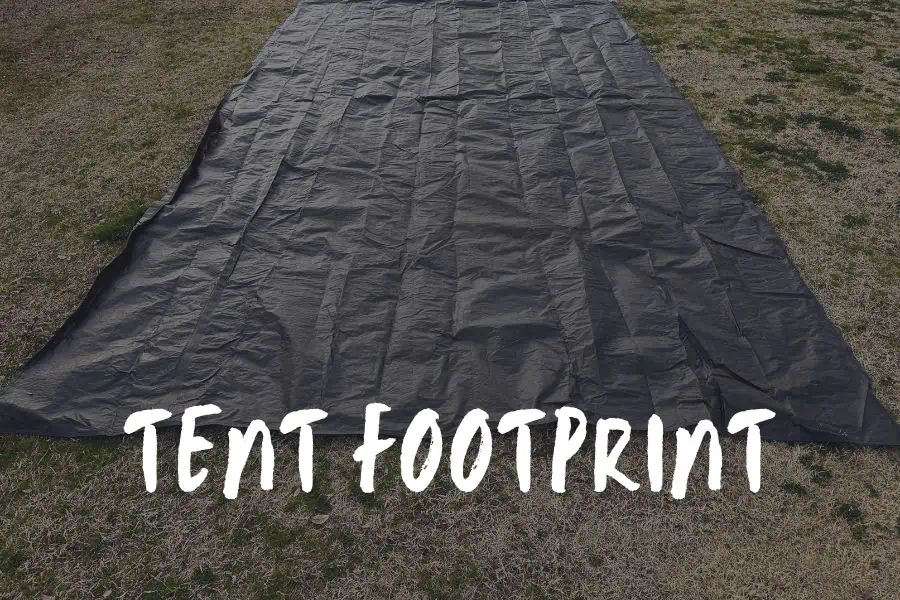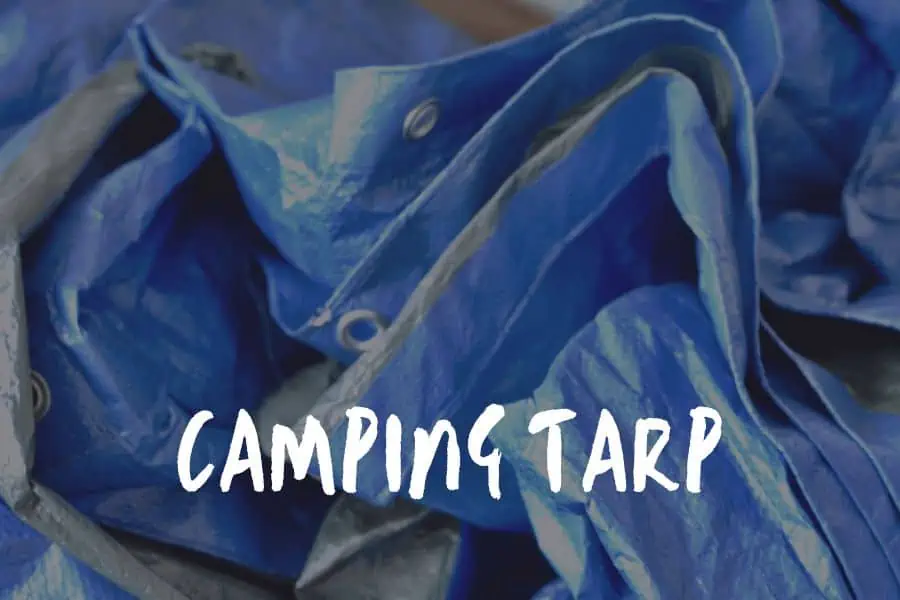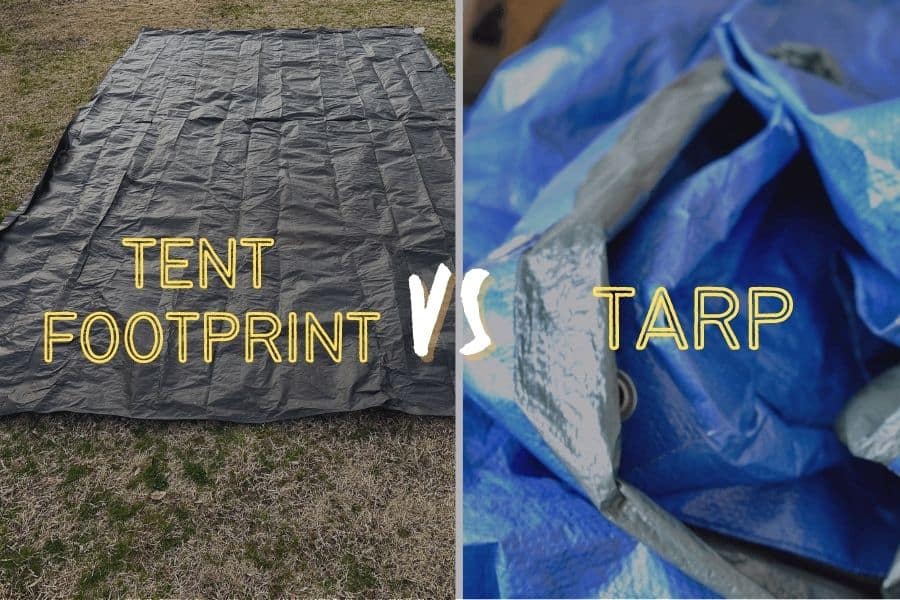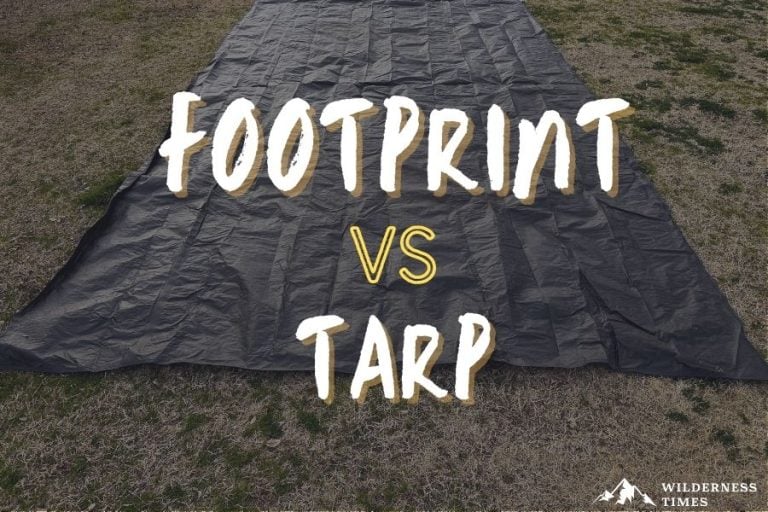Damaging your tent is easier than you might think.
Any time you pitch a tent on its own on rough terrain, its floor is getting worn down, bit by bit.
You’re playing Russian roulette with your tent’s life.
To prolong the lifespan of your tent, it comes down to two choices: get a tent footprint or a tarp. But which is better?
While both have pros and cons, we find the winner by a slight edge is the tent footprint:
Table of Contents
ToggleTent Footprint – Why We Love It

A tent footprint is a piece of material that’s specially designed by the tent manufacturer to go underneath your camping tent.
Nowadays, most tents are made of thin fabrics in order to be compact and lightweight. Their floors, although waterproof and thicker than the walls, aren’t too sturdy.
That’s why footprints are designed to protect your tent floor from unnecessary damage and wear and tear caused by the surface you place it on.
They come in different shapes and sizes, intended to match your tent perfectly.
Tent footprints are made of different materials, from polyester and nylon to rubber and even Tyvek.
What do these materials have in common?
They’re waterproof!
Aside from extra protection against abrasive surfaces, this is one of the most important functions of a tent footprint.
Which brings us back to my previous point – tent footprints are made to match a specific tent’s floor dimensions. If it was larger, extending past the edges of your tent, rain would find its way underneath, and you could say hello to a puddle below your tent.
On each side, footprints are generally 1 to 2 inches smaller than the specific tent they’re made for, to avoid this rain issue. For most tents, you can find a fitting footprint on the market.
I won’t lie, they’re not usually cheap.
But, this cost is nowhere near the price of a new tent if you damage your floor. Personally, I’m extremely picky when buying a new tent. That’s why I’d rather spend a little extra money on floor protection to extend its life, than go through that meticulous and expensive process again.
One thing you should know is that tent footprints aren’t exactly featherweight. In fact, you can expect them to weigh approximately 25% of your tent’s weight. That’s something to keep in mind when going backpacking or thru-hiking.
Pros:
- Reduces the amount of heat loss to the ground
- Allows you to pitch your tent faster, thanks to the grommets where the poles go in
- Fits your tent perfectly
Cons:
- Not versatile, only serves as a groundsheet
Using a Camping Tarp as a Tent Footprint

If you thought a tent footprint was your only option, you were wrong.
A tarpaulin (or tarp) is the most versatile piece of camping gear, and can work great as a groundsheet, too.
It’s waterproof and extremely durable – both features a tent footprint needs to have.
In case of an apocalypse, a camping tarp would be one of the first things I’d pack. Nay, I’d probably wear it as a cape.
I find a tarp to be one of the best camping inventions ever made. It’s lightweight but strong enough to withstand the elements.
All the elements. Wind, rain, sun, snow…
When properly used, you can make a tarp shelter in any and all weather conditions with such a simple piece of material. But I’ll stop here before my digression gets out of hand.
When used as a DIY tent footprint, a tarp does everything you need it to do. It protects the tent floor from harsh terrain, as well as adding an extra layer of waterproofing.
But, there’s a catch. Remember how tent footprints are slightly smaller than the tent floor to prevent water from collecting between the two layers? Well, your tarp shouldn’t extend past the tent edges either.
Finding a tarp that’s the right size for your tent is rather difficult, so some modifications might be in order. You’ll need to either cut it to size or fold it.
Plus, depending on the material, a tarp might tear on extremely rough terrain. But, hey, I guess that’s why you put it down in the first place, right?
Pros:
- Generally cheaper than a footprint
- Can also be used as protection against all weather elements
- Can serve as an emergency shelter
Cons:
- Needs some adjustments to fit properly under your tent
- Can be quite bulky
Tent Footprint vs Tarp – Which is best?

Both tarps and tent footprints can serve the same purpose, without a doubt.
But the real question is – can they do it equally well?
And to get the most precise answer, let’s compare some of their most important features:
Coverage
Like I said, tent footprints are designed to fit a specific tent. So if you own two tents of different shapes or sizes, you’re going to need two footprints as well.
Tarps will give you the coverage you need, and a little extra. But in this case, you don’t want any extra, because water will accumulate if you leave it exposed.
So you’ll need to adjust your tarp to get the perfect fit.
Some campers cut their tarps to get the right coverage, a method that I’m not fond of.
Depending on the tarp material, cutting could cause the ends to fray. And besides, you’ll remove the grommets on the sides you cut, and these are quite useful for keeping a tarp in place.
Instead, I recommend simply folding it to your tent size, just prior to pitching your tent.
Portability
If you’re backpacking, this is probably the most important feature of every piece of equipment. Especially if you’re an ultralight backpacker.
Your groundsheet needs to be lightweight and compact when packed, or else it will only slow you down.
Portability depends a lot on the materials these things are made of, as well as their size. Generally, tarps are larger, and you can expect them to be slightly heavier. Plus, they’re usually bulkier when packed.
Material
For the most part, tent footprints, and tarps are made of either nylon or polyester.
Both materials are water-resistant. But they’re also additionally treated with a waterproof coating, to fully protect you from the elements.
Other, not-so-popular choices of material include Tyvek, polycryo, silnylon and Cuben Fiber. They’re all water-resistant fabrics, but their other characteristics like weight or breathability are the reason they don’t often make the cut.
Both a tarp and a tent footprint can be made of either one of these materials, so your choice of fabric doesn’t affect your choice of groundsheet.
Terrain
Any rough surface requires some sort of tent floor protection.
Well, if you want your tent to live another camping day, that is.
Believe it or not, this also includes sand. While you might enjoy walking barefoot on sand, your tent doesn’t share your enthusiasm.
Both a tent footprint and a tarp will work well on different surfaces. But, as much as I love using a tarp, I must admit that a footprint will do a slightly better job.
After all, they’re made for this very purpose.
Weather
The reason I rave so much about tarps is because they’re great for all weather conditions.
Depending on the forecast, you can decide if it’s more needed below or above the tent.
Tent footprints, on the other hand, are designed to protect your tent from underneath only.
But, if it’s really, really cold, a thick footprint will not only keep you dry, but warm too.
It’s a great insulator, and if you’re winter camping, I’d pick it over a tarp.
Affordability
Pricewise, tarps are generally very affordable. Polyethylene tarps are pretty much a steal, but even nylon ones won’t cost you a pretty penny.
When it comes to tent footprints, they’re made of the same material as their respective tents. So, if your tent was expensive, you can expect the footprint to hurt your wallet, too.
Tarp vs. Tent Footprint Compared
FAQs
Is it worth getting a tent footprint?
While not an absolute necessity, a tent footprint prolongs the life of your tent, so it’s a good addition to your gear.
However, a tent footprint can be more expensive, which is why many campers go for a tarp instead.
Can I use any tarp for a tent footprint?
A tarp needs to be the same length as the bottom of the tent. If it’s shorter, it won’t be as effective.
A longer tarp, on the other hand, will cause water to collect underneath the tent. Luckily, you can avoid that by fitting your tarp to size.
We do this by folding it down to the correct size right before pitching our tent.
Do you need a tarp under a tent with a footprint?
If you already have a tent footprint in place, there’s no need to add a tarp underneath.
However, it’s not a horrible idea to use a tarp as well when camping on a really harsh surface, as it will keep your tent footprint from wearing down.
How can I make a cheap tent footprint?
You can get a tarp or a tyvek sheet (a waterproof, puncture-proof material), that you can adjust in size to fit your tent bottom.
Adding grommets to each side requires a bit more work, but it’s easily done with a few basic tools.
Should a tent footprint be waterproof?
Yes, a tent footprint, just like the tent floor, should be waterproof.
And going with the double-proofed bottom is never a bad idea, as you’re twice as sure you’ll remain dry inside the tent, regardless of the weather.
The Final Verdict
Both a tent footprint and a tarp can do a great job at protecting your tent from abrasion as well as keeping it dry. Ultimately, the choice is situational.
If you’re camping on rough terrain, a tent footprint is a slightly better choice.
If you want a more affordable and versatile option, then a tarp is what you need.
But, if possible, get both! That way, no terrain or weather conditions can ruin your camping trip, and you simply decide between either option as you are setting up camp.
More on Tarp & Tent Materials:


